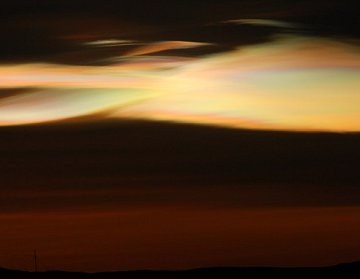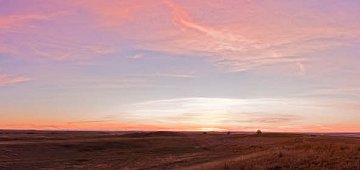| AURORA WATCH: Sky watchers from Alaska to Scandinavia should be alert for auroras tonight. A solar wind stream is buffeting Earth's magnetic field and causing arctic geomagnetic storms: gallery. ANTARCTIC CLOUDS: It's that time of year again; the ozone hole is opening over the South Pole. People in Antarctica need no special instruments to know this is happening. They can tell just by looking at the sky: 
"These are Type II Polar Stratospheric Clouds (PSCs) over Australia's Mawson station in Antarctica," says Andrew Klekociuk of Australia's Antarctic Division. "This type of cloud is intimately associated with the formation of the ozone hole, which is currently reaching peak size." PSCs form when temperatures in the stratosphere become extremely cold, below -78° C. ("Balloon-measured temperatures in the vicinity of the clouds were -86 degrees C," notes Klekociuk.) They spell trouble for ozone; tiny ice crystals and droplets within the clouds provide surfaces where CFCs are converted into ozone-destroying molecules. Those same crystals diffract sunlight, producing vivid nacreous colors. Peter Tsimnadis of Mawson Station took the picture using a Nikon D80 on Aug. 28th. Other similar displays have been seen since. Klekociuk says, "see our web site for more information." HARVEST MOON 360: The sky is a big, beautiful place. Unfortunately, human eyes can only see about 180o of it at once. Click on the sunset to experience the full 360o: 
"I created the panorama by stitching together 12 frames shot at 30° intervals using my Canon 20Da camera," explains photographer Alan Dyer of Bassano, Alberta. "It was the night of the Harvest Moon, Sept. 14th. Note the Moon rising in the east embedded in the arc of Earth's shadow and the bright western sky opposite the Moon on the left. The clouds added wonderful color." All in all, "it nicely captures the 'big sky' scene of a prairie sunset and moonrise," he says. more images: from Tom Soetaert of Lawrence, Kansas; from Mohamad Soltanolkottabi of Esfahan, Iran; from Michel Hersen of Portland, Oregon; from Erik Thibado of Eau Claire, Wisconsin;
Sept. 2008 Aurora Gallery
[Aurora Alerts] [Night Sky Cameras] | 
